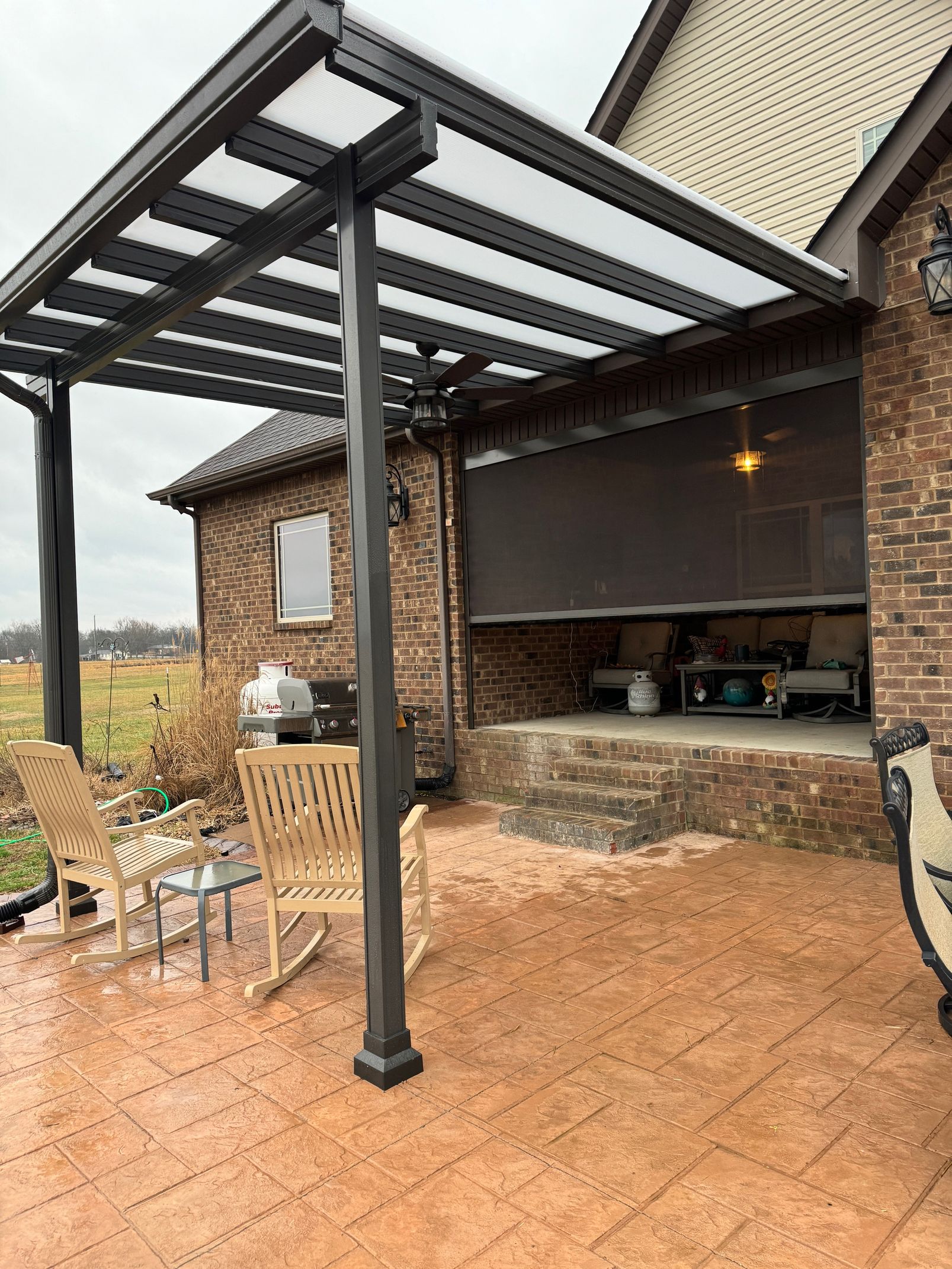Screen Enclosures 101 - Maximize Your Outdoor Living Space
Sergio Mota • March 22, 2024
Screen Enclosures 101: Everything You Need to Know
Picture this: a serene, insect-free outdoor space where you can enjoy a perfect view of your GARDEN & entertain guests without any unexpected rain showers spoiling the fun.
For homeowners & DIY enthusiasts looking to enhance their living space, the addition of a screen enclosure can transform visions of an ideal outdoor retreat into a reality.
In this guide, we'll cover everything you need to know about screen enclosures, from the numerous benefits they offer to the various options at your disposal, & how to maintain these structures to ensure you savor their comfort for years to come.
- The Benefits of Screen Enclosures
- The Ultimate Insect Shield
- Unlike traditional open-air patios or porches, a screened-in space acts as a barrier against mosquitoes, flies, & other unwanted bugs, allowing you to enjoy the great outdoors undisturbed.
- Increased Privacy
- It's an excellent solution for urban homes with neighboring properties in close proximity or for those who prefer to keep their outdoor activities out of the public eye.
- Versatility and Flexibility
- A screen enclosure doesn't just provide shelter from the elements & insects; it also adds a versatile living space that can be used for various purposes.
- Property Value Boost
- Potential buyers appreciate the added living space & benefits it provides, which can often translate to a higher market value for your property.
- Types of Screen Materials
- Choosing the Right Mesh
- When it comes to selecting the mesh material for your screen enclosure, you have a few key choices:
- Fiberglass: A popular choice due to its durability & affordability. It offers good visibility & protection.
- Aluminum: Aluminum screens provide excellent strength, but this may come with a reduction in transparency & additional cost.
- Pet-Resistant Screens: If your four-legged friends also enjoy the outdoors, pet-resistant screens, usually made from a combination of polypropylene & polyester, are built to withstand their curious claws.
- Specialty Screens: There are specific meshes designed to address unique needs, such as sun control, improved airflow, or even the containment of pollen for those with allergies.
- Frame Materials
- The type of frame you choose will depend on your budget, aesthetic preferences, & environmental considerations. Common options include:
- Aluminum: Light, durable, & resistant to corrosion, aluminum is the top pick for many homeowners.
- Vinyl-Laminated Wood: Provides the warm look of wood with the benefit of added weather & insect resistance.
- Stainless Steel: For those in extremely harsh, coastal environments, stainless steel offers the ultimate in durability.
- PVC: A more budget-friendly choice, PVC is often the go-to for those looking for a low-maintenance option.
- Maintenance for Longevity
- Regular Inspections
- Early detection of issues such as tears in the screen or rust on the frame is crucial for preventing more significant problems. Regular visual checks can spot these issues before they develop into costly repairs.
- Cleaning the Enclosure
- Keeping your screen enclosure clean not only ensures it looks its best but also maintains the structural integrity of the materials.
- Functionality Check
- Don't forget to ensure that all doors, latches, & hardware are in good working order. Damaged or faulty components can compromise the security & insect resistance of your enclosure.
- Professional Maintenance
- Some maintenance tasks are best handled by professionals. Periodic inspections by a screen enclosure specialist can catch issues early & provide repairs or replacements to extend the life of your structure.
- DIY or Professional Installation?
- Pros & Cons of Going DIY
- For the avid DIY-er, constructing a screen enclosure can be a challenging & rewarding project. It allows for custom sizing & design, & there's a sense of accomplishment in building it yourself. However, it's important to consider the complexity of the build & that mistakes can be more costly than hiring a professional.
- Choosing a Professional
- Professional installers bring expertise, experience, & a network of reliable suppliers to ensure the job is done right the first time. They'll also be more aware of local building codes & ensure your enclosure meets all safety & structural requirements.
- Financing Your Enclosure Project
- Understanding Costs
- The cost of a screen enclosure can vary greatly depending on its size, the materials used, the complexity of the structure, & labor costs.
- Exploring Financing Options
- Several financing options can help make your screen enclosure dreams a reality:
- Personal Loans: For smaller projects, a personal loan can provide quick access to the funds you need.
- Home Equity Line of Credit (HELOC): If you're looking to upgrade your home & have equity, a HELOC can offer competitive interest rates for larger projects like screen enclosures.
- Credit Cards: While not ideal due to high interest rates, credit cards can offer a quick solution for financing smaller portions of your project if you have the ability to pay them off quickly.
- Design Considerations for Your Screen Enclosure
- Siting & Function
- Before you even think about materials or financing, consider the purpose of your space. Will it be a dining area, a playroom for your children, or a place to simply lounge & relax? The answers to these questions will inform the size, shape, & design of your enclosure.
- Blurring the Lines Between Indoors & Out
- A well-planned screen enclosure can effectively extend the living space of your home into the surrounding landscape. Consider design elements such as flooring, lighting, & furniture that create a cohesive transition from your indoor space to the screened-in area.
- Navigating Building Codes
- Whether you're going the DIY route or hiring a professional, it's crucial to be familiar with local building codes & permit requirements to avoid any legal complications. Your design choices should always align with these regulations.
- Finalizing Your Screen Enclosure Project
- Project Management
- Managing the scope, timeline, & budget of a screen enclosure project can be a significant undertaking. Plan for unexpected delays & costs upfront & consider utilizing project management software or hiring a project manager to keep everything on track.
- Enjoying Your New Space
- Once your screen enclosure is complete, it's time to enjoy the fruits of your labor. Personalize the space with plants, comfortable seating, & all the essentials for whatever activities you plan to enjoy. Whether it's rejuvenating in a hammock with a good book or hosting a garden party, your screen enclosure is an asset to your property that provides endless possibilities for outdoor enjoyment.
Screen enclosures offer a host of benefits that can enhance the quality of life for you & your family, as well as add value to your home. Understanding the materials, maintenance, & design considerations is critical in making informed decisions that lead to a successful & lasting addition to your property. By exploring the possibilities & taking a thoughtful, step-by-step approach, you can turn your outdoor space into a comfortable, functional, & enjoyable oasis!

5 Reasons why Aluminum Patio Covers is the Go-To Choice: Aluminum patio covers are LOW MAINTENANCE. Just give them an occasional rinse with soapy water and wipe down! Aluminum is DURABLE, it can better withstand the elements, and it's rust-resistant ensuring it to last many years. Aluminum patio covers are VERSATILE, they comes in a variety of colors, sizes, and shapes. Aluminum patio covers are ideal for budget conscious homeowners making it COST-EFFECTIVE. You can easily CUSTOMIZE aluminum patio covers with different designs, colors, and shapes. With its low maintenance, durability, versatility, cost-effectiveness, and customizability, aluminum is the ideal material for your new patio cover. No matter what you're looking for, aluminum offers plenty of options to fit your budget and provide long-term peace of mind. Have questions? Contact us today to find the perfect aluminum patio cover for your home!

Thinking about upgrading your outdoor living space? A patio cover might be just what you need. Not only does it extend your usable space, but it also adds value to your home. Here’s what you should know before making this fantastic investment. Benefits of Adding a Patio Cover: Protection from the Elements - A patio cover provides essential protection from rain, snow, and harsh sunlight. This means you can enjoy your patio year-round without worrying about the weather. Plus, your plants and furniture will be shielded from extreme conditions, ensuring they last longer. Increased Home Value - Installing a patio cover significantly boosts your home's value. It offers an attractive feature for potential buyers and creates a versatile space for barbecues, gatherings, and relaxation. Even if selling isn't on your radar, this upgrade enhances your home’s resale value, making it easier to sell in the future. Reduced Maintenance - A patio cover helps keep your deck or patio clean by preventing dirt and debris from accumulating. With less cleaning required, you’ll spend more time enjoying your space rather than maintaining it. Opt for an aluminum patio cover, and you can forget about regular painting or staining—aluminum resists fading and requires minimal upkeep. Patio covers offer numerous benefits, from weather protection to increased home value and reduced maintenance. With various styles and budgets available, you’re sure to find the perfect solution for your outdoor space needs. Enjoy more time relaxing outdoors and less time on upkeep tasks. Ready to enhance your outdoor living? Explore your options and invest in a patio cover today!






